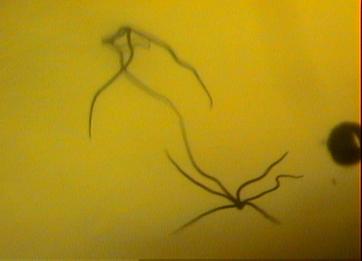Morgellons is not a delusion. Many people say things like “Morgellons is just another name for Delusions of Parasitosis”, or “Morgellons sufferers are imagining their symptoms”, or “doctors dismiss Morgellons sufferers as delusional”. This is all wrong.
What is Morgellons? Morgellons is a list of symptoms of unknown causes. The main symptoms are skin lesions, itching, crawling sensations, the finding of fibers on the skin, and also other symptoms similar to Chronic Fatigue Syndrome.
Where is the delusion?
Skin lesions are not a delusion. There are thousands of reasons you can get skin lesions. People get them all the time. Obviously, they are not a delusion, as everyone can see them clearly on the skin of the people who have them.
Itching is not a delusion. It’s a symptom of a condition. There are thousands of conditions that can cause itching, including both medical conditions and environmental conditions. Itching and skin lesions can also cause each other, if you scratch an itch, it can cause a lesion, and the skin damage can cause more itching. This is called the itch-scratch-itch cycle, and it is not a delusion.
Crawling sensations are not a delusion. Like with itching, crawling sensations are a symptom of a condition, probably to do with the nerves in the skin. Crawling sensations are sometimes called “formication”, which is unfortunately sometimes defined as an “illusion or hallucination” that insects are crawling on your skin. This makes it sound like a delusion. But formication is not a delusion. It’s a sensation that feels like insects crawling under your skin. It is like when you have a high fever, but you feel cold. It’s not actually cold, but it still feels cold. Is that a delusion? No, it just feels like it is cold because the fever is creating the “illusion or hallucination” of cold. Really it’s just a sensation, and calling it a “hallucination” is a bit much. It’s not like you saw a ghost or something. Formication is not a delusion.
Finding fibers on the skin is not a delusion. If you can see a fiber (and other people can see it too), then it’s real. Fibers are everywhere. It’s not at all unusual to find fibers on your skin, I find them myself all the time. Skin also has a lot of fibers, and things that could look like fibers, naturally in it. Things like hair, blood vessels, nerve fibers, skin tissue, and sebum. These are not delusions.
I don’t think it is right to say “Morgellons is a delusion”. Lots of people have these real symptoms. They believe that their symptoms are linked to the fibers and that this means they have a distinct disease. I agree with the CDC when they say there is not sufficient evidence to say that Morgellons is a distinct disease, and I don’t think the fibers are related to the majority of the symptoms. So I think many people are making a mistake in saying they “have Morgellons”. I also think their health might suffer because of this mistake.
Morgellons is not a delusion. It’s a list of symptoms with many causes. Sometimes people have very strong beliefs about the connection between finding fibers and their other symptoms. Sometimes they describe things that sound impossible, like fibers moving by themselves and crawling out of the skin. If all the evidence shows the fibers are not connected to the symptoms, and they continue to believe unusual things about the fibers, then that might mean they are delusional about that.
But that does not mean their other symptoms are not real. Lesions, itching, crawling sensation, and even finding fibers, all these are real things. The fact that some people have some specific delusions about a part of their health does not mean that all their health problems are delusions. They have their health problems, and they maybe have some delusions. For some people, their delusions might be so strong that they interfere with treating their other symptoms. But this does not mean that all their symptoms are delusions. Morgellons is not a delusion, it’s a list of symptoms.
(addendum)
This is not just semantics. Doctors are quoting as saying that Morgellons IS Delusions Of Parasitosis, and you can treat it with Orap. Suppose a 50-year old woman goes to the doctor and says she’s itching, has a sensation of insect crawling under her skin, she’s breaking out in acne, the itching makes her scratch so much she bleeds, she has muscle and joint pain, vision problems, hair loss, swelling, fatigue, irritability, insomnia, inability to concentrate, depression, memory loss, headache, anxiety, and nervousness. She saw the ABC special on Morgellons, and examined her acne and found some fibers. So she begins to think she has Morgellons. She goes to the doctor, says “I think I have Morgellons”, and hands him a printout of the MRF case definition, and a plastic bag with some fibers and specks she found in her lesions, and urges him to look at the fibers on her skin. So, should the doctor prescribe Orap?
No. She does not have Morgellons, she has Menopause (menopause is the medical condition that most closely matches the Morgellons list of symptoms, and a very large proportion of people who think they have Morgellons are women of menopausal or perimenopausal age).
The doctor should prescribe treatment for the symptoms, possibly HRT for the menopause, they should explain that the formication and other symptoms are common effects of menopause, they can be reduced with treatment, and will eventually go away. He should explain that the fibers are probably just lint or hair and that the CDC says there is not enough evidence to say Morgellons is a distinct disease.
Then if she remains convinced that Morgellons is behind this, and this is interfering with her health, then the doctor should treat that delusion as well as the other symptoms. She may be delusional, but she’s still menopausal.
Morgellons is not a delusion. It’s a broad list of symptoms with no evidence of a common cause. It’s easy for some people to think they have it since the symptom list is so vague. Sometimes people become obsessively convinced they “have it” and that the fibers they find on their skin are connected to “it“, and they start picking them out. That’s a delusion. Sometimes the other symptoms are somatic manifestations of the delusion, and the Orap will fix them, but a lot of times the delusion has a physical basis that also needs to be addressed. Sometimes, the delusion is just a mistake.



